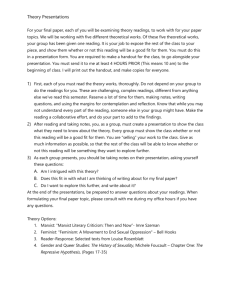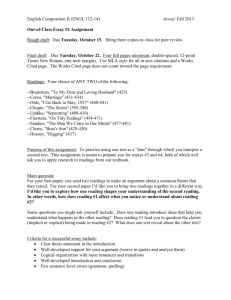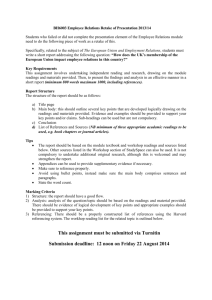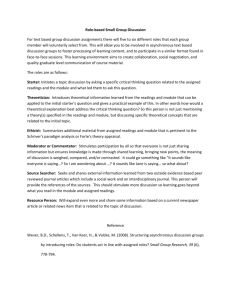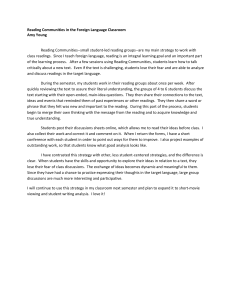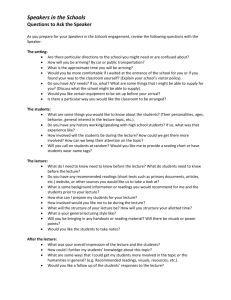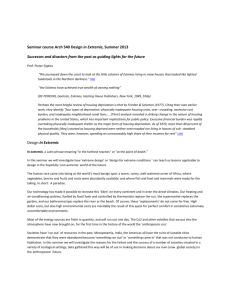TMP 291OI_Syllabus - UCSB's Technology Management Program
advertisement
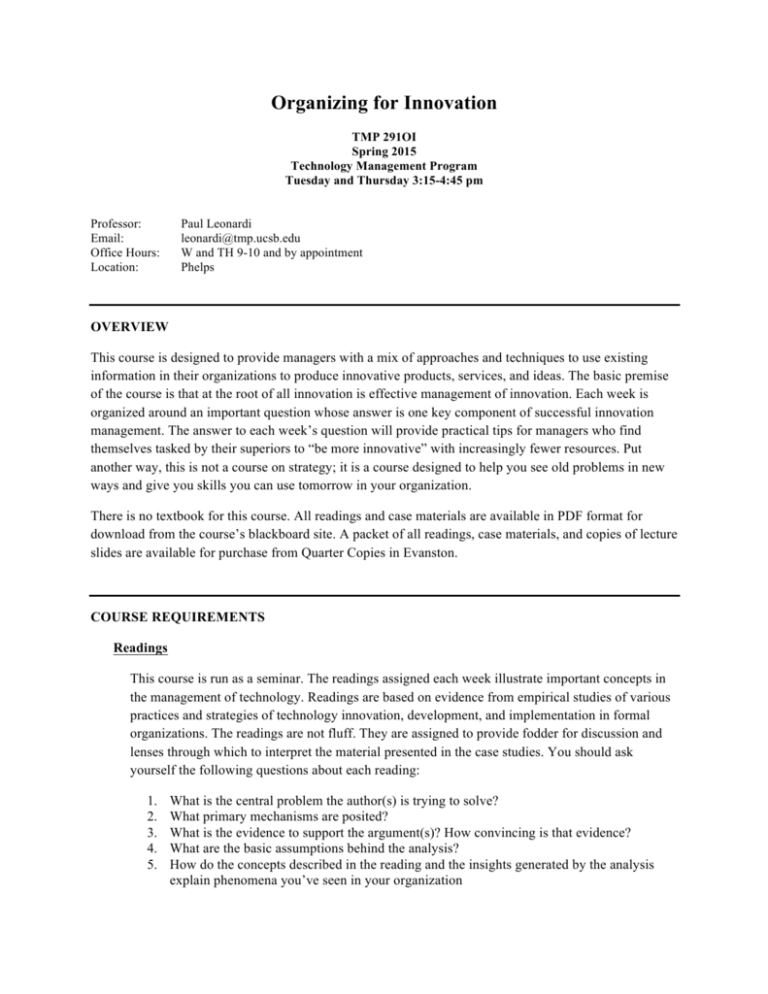
Organizing for Innovation TMP 291OI Spring 2015 Technology Management Program Tuesday and Thursday 3:15-4:45 pm Professor: Email: Office Hours: Location: Paul Leonardi leonardi@tmp.ucsb.edu W and TH 9-10 and by appointment Phelps OVERVIEW This course is designed to provide managers with a mix of approaches and techniques to use existing information in their organizations to produce innovative products, services, and ideas. The basic premise of the course is that at the root of all innovation is effective management of innovation. Each week is organized around an important question whose answer is one key component of successful innovation management. The answer to each week’s question will provide practical tips for managers who find themselves tasked by their superiors to “be more innovative” with increasingly fewer resources. Put another way, this is not a course on strategy; it is a course designed to help you see old problems in new ways and give you skills you can use tomorrow in your organization. There is no textbook for this course. All readings and case materials are available in PDF format for download from the course’s blackboard site. A packet of all readings, case materials, and copies of lecture slides are available for purchase from Quarter Copies in Evanston. COURSE REQUIREMENTS Readings This course is run as a seminar. The readings assigned each week illustrate important concepts in the management of technology. Readings are based on evidence from empirical studies of various practices and strategies of technology innovation, development, and implementation in formal organizations. The readings are not fluff. They are assigned to provide fodder for discussion and lenses through which to interpret the material presented in the case studies. You should ask yourself the following questions about each reading: 1. 2. 3. 4. 5. What is the central problem the author(s) is trying to solve? What primary mechanisms are posited? What is the evidence to support the argument(s)? How convincing is that evidence? What are the basic assumptions behind the analysis? How do the concepts described in the reading and the insights generated by the analysis explain phenomena you’ve seen in your organization Each week you will read several papers on a similar topic. When viewing the papers collectively you should ask yourself the following: 1. Do these papers provide complementary or conflicting evidence about the phenomenon in question? 2. Are there shortcomings in one the approach taken by one paper that could be addressed by another paper? 3. Consider a project that you’ve worked on in your organization, if you were to do it over again how would you use the insights from these readings to do things differently? We will discuss aspects of all the readings in class. After all, there’s no point in reading them if we don’t implement their ideas! I will assume you have read all the materials and I will call on class members to answer questions. Class Participation (20% of Final Grade) We’ll begin each class period by discussing the assigned case. The cases are selected to present students with a problem that can be solved in a number of ways. In some instances, the concepts from the readings may help to solve the problem, in others they won’t. As a class, we will discuss different options to solving case problems and evaluate how well we think each of these options would work. When we discuss cases in class, you should employ the following strategies: 1. Make sure you are considering the problem that is presented in the case. 2. Think of four to five sub-questions that you need to answer before you can address the overall issue. 3. When discussing a specific issue, remember why you are discussing it and where it fits into the overall problem. 4. If you have considered some alternatives and rejected them, tell us what and why. 5. Summarize what you have learned and what the implications appear to be. 6. Don’t fixate on "cracking the case." It is much more important to follow a logical thought process than to arrive at the solution. After our discussion, I will normally provide a general overview of the concepts for the day and a broad synthesis of the readings. Our goal in class discussion is application. You should leave class each day with some ideas about how you could apply the concepts we discuss to real projects in your organization. We will talk about each of the readings in more depth. I will ask that you apply as many of the concepts as you can to projects, events, or strategies that you’ve encountered throughout your career. When you share, it helps others to learn – and vice-versa. Reaction Papers (30% of Final Grade) You are required to submit four reaction papers. The four classes for which you submit reaction papers are up to you – reaction paper questions are available for every class save the first and last. These papers should be limited to one single sided page maximum. The paper should contain your response to the “reaction paper question” designated in the syllabus for that day. Since the purpose of the reaction paper is to invigorate your thinking in preparation for class discussion, these papers must be submitted before 3PM on Wednesday before class in order for you to receive credit for your work. Submit all work electronically to: leonardi@northwestern.edu. You should include your work both in the body of the e-mail message AND as an attachment. The subject header should begin with your last name and the words “reaction paper” (Example: Lee – reaction paper.) Reaction papers are graded with a score 0-10. Most papers receive am 8. Typically, aboveaverage responses go beyond simply describing the concepts and examples from the day’s readings, and demonstrate the author’s ability to make broader connections and synthesize new ideas, without exceeding the word limit. Process Audit (50% of Final Grade) You will work with one other class member to perform a “process audit” for one of your supervisors. You will use the answers we discussed during two of our class weeks (which two is up to you) to diagnose whether and why a particular attempt at innovation was successful or not. You will then recommend actions to your supervisor, based on course concepts, which will encourage more effective behavior. You will find your job less complex if you focus on one particular technology or service, and perhaps even one particularly successful (or disastrous) attempt at innovation, development, or implementation. The project will be graded on five criteria. 1. How well do you integrate concepts (e.g., structural holes, disruptive innovations, networks, framing, etc.) into your analysis? 2. Are you able to make comparisons with other examples, such as the cases we've discussed in class? 3. Is your work expressed clearly, or is it difficult to follow? 4. Is your analysis insightful? Does it go beyond simply describing what happened and speculate on why it happened? 5. How relevant and useful are your recommendations? Write-ups must be limited to 2000 words (excluding figures, tables, and appendices). One of the biggest challenges of the assignment is to determine how to present relevant material about your company's technology, organization, and markets without losing the space you need for analysis. Points will be deducted from write-ups that exceed this limit. The written portion of this assignment is due on the last day of class. On the last day of class, each team of two will give an 8-minute (strictly enforced) overview presentation of their process audit to the class outlining your findings and recommendations. COURSE SCHEDULE Week 1: What Am I Managing When I Manage Innovation? Tuesday Thursday READINGS CASE 1. 1. Integrating Innovation Style and Knowledge Into Strategy 2. Finding the Right Job for Your Product Positioning the tablet PC ***Purchase Case from http://hbr.org/product/microsoft-positioning-the-tabletpc/an/502051-HCCENG?Ntt=1.%2509Positioning%2520the%2520tablet% 2520PC REACTION QUESTION What methods would you use to be able to define products by jobs as opposed to categories? Week 2: How Does Information Move Through the Organization? Tuesday Thursday READINGS CASE 1. 2. 1. Informal Networks: The Company Behind the Chart What’s Your Strategy for Managing Knowledge? Global Knowledge Management at Danone ***Purchase Case from http://hbr.org/product/global-knowledgemanagement-at-danone-a/an/608107-PDFENG?Ntt=1.%2509Global%2520Knowledge%2520 Management%2520at%2520Danone REACTION QUESTION What is the best way to assure that you know what other people in your organization know? Week 3: Can I Use Web 2.0 Tools to Capture Information and Turn it into Knowledge? Tuesday Thursday READINGS CASE 1. 1. 2. Why Information Technology Inspired But Cannot Deliver Knowledge Management Enterprise 2.0: The Dawn of Emergent Collaboration Cognizant 2.0: Embedding Community and Knowledge Into Work Processes ***Purchase Case from http://hbr.org/product/cognizant-2-0-embeddingcommunity-and-knowledge-in/an/410084-PDFENG?Ntt=1.%2509Cognizant%25202.0%253A%25 20Embedding%2520Community%2520and%2520K nowledge%2520Into%2520Work%2520Processes REACTION QUESTION What conditions need to be present for an information technology to be useful in helping people in the organization share information? Week 4: How Do I Manage Team Structure to Help Generate and Implement New Ideas? Tuesday Thursday READINGS CASE 1. 2. 1. IDEO Product Development *** Purchase Case from http://hbr.org/product/ideoproduct-development/an/600143-PDFENG?Ntt=ideo%2520product%2520development Building an Innovation Factory Why Project Networks Beat Project Teams REACTION QUESTION If your primary workgroup is tasked with increasing its innovation, who should your team members be connected to? Are there any connections people currently have that could or should be eliminated? Week 5: MIDTERM AND MIDTERM RECOVERY DAY Week 6: How Can I Promote Cooperation in Cross-Functional Teams? Tuesday Thursday READINGS CASE 1. 1. 2. Hurdle the Cross-Functional Barriers to Strategic Change Why Leaders Don’t Learn from Success Sacred Ground (VIDEO TO BE SHOWN IN CLASS) REACTION QUESTION How can you reap the advantages of a cross-functional team while simultaneously breaking down its interpretive barriers? Week 7: How Do I Manage Culture to Help Generate New Ideas? Tuesday Thursday READINGS CASE 1. 2. 1. Emotion and Creativity at Work How Pixar Fosters Collective Creativity Innovation and Collaboration at Merrill Lynch *** Purchase Case from http://hbr.org/product/innovation-and-collaborationat-merrill-lynch/an/406081-PDFENG?Ntt=1.%2509Innovation%2520and%2520Coll aboration%2520at%2520Merrill%2520Lynch REACTION QUESTION How do you balance creativity with the need to be productive? Week 8: What is the Best Way to Get People to Buy-In to my Newly Generated Ideas? Tuesday Thursday READINGS CASE 1. 2. 1. Leading Change: Why Transformation Efforts Fail Harnessing the Science of Persuasion Internal Entrepreneurship at the Dow Chemical Company *** Purchase Case from http://hbr.org/product/internal-entrepreneurship-atthe-dow-chemical-co/an/IMD145-PDFENG?Ntt=1.%2509Internal%2520Entrepreneurship %2520at%2520the%2520Dow%2520Chemical%25 20Company REACTION QUESTION Should I sell ideas in different ways to my supervisors and my subordinates? Why? Week 9: How Do I Successfully Implement New Innovations within My Company? Tuesday Thursday READINGS CASE 1. 2. 3. 1. Four Questions Every CEO Should Ask About IT Framing for Learning Six Key Dimensions of Understanding Media Providian Trust: Tradition and Technology *** Purchase Case from http://hbr.org/product/providian-trust-tradition-andtechnology-a/an/398008-PDFENG?Ntt=Providian%2520Trust REACTION QUESTION How tightly should you manage the way people use a technology after it is implemented? Week 10: FINAL PRESENTATIONS
